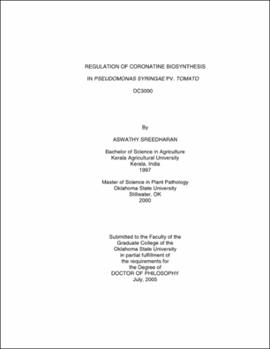| dc.contributor.advisor | Bender, Carol L. | |
| dc.contributor.author | Sreedharan, Aswathy | |
| dc.date.accessioned | 2013-11-26T08:23:49Z | |
| dc.date.available | 2013-11-26T08:23:49Z | |
| dc.date.issued | 2005-07 | |
| dc.identifier.uri | https://hdl.handle.net/11244/6754 | |
| dc.description.abstract | Scope and Method of Study: The phytotoxin coronatine (COR) is produced by various pathovars of Pseudomonas syringae, including P. syringae pv. tomato DC3000, which is pathogenic on crucifers and tomato, and P. syringae pv. glycinea PG4180, a soybean pathogen. The COR molecule contains two distinct components: coronafacic acid (CFA) and coronamic acid (CMA), which both function as intermediates in the COR biosynthetic pathway. In PG4180, COR biosynthesis is regulated by a modified two-component regulatory system consisting of genes encoding two response regulators, corR and corP, and the histidine protein kinase, corS. DC3000 also contains corRPS; however, it is not clear whether corR, corP, and corS regulate CFA and CMA synthesis as they do in PG4180. Furthermore, studies were designed to investigate whether cross-talk exists between the type III secretion system (TTSS) and COR biosynthesis, which are both required for virulence in DC3000. | |
| dc.description.abstract | Findings and Conclusions: We observed that similar to PG4180, corR and corS mutants of DC3000 fail to produce COR, CFA and CMA. A mutation in hrpL, which encodes an alternate sigma factor (sigma L), required for the expression of various transcripts in the hrp gene cluster, abrogated production of COR in DC3000, suggesting that mutations in the TTSS may have regulatory effects on the production of virulence factors such as COR. The presence of a potential Hrp box, the recognition site for sigma L, upstream of corR suggested that corRS might be modulated by hrpL. This was confirmed in RT-PCR experiments showing that the upstream effector gene holPtoAA, which was associated with the Hrp box, was co-transcribed with the corRS, constituting an operon (holPtoAA- corR- corS). Furthermore, we also show that mutations in corR and corS have regulatory effects on the expression of hrpL and hrpA. This finding was validated in gel shift studies showing that CorR binds to nucleotide sequences upstream of hrpL. To our knowledge, these results provide the first example showing that cor regulatory system can directly impact the expression of hrp regulon in P. syringae. We also used capillary zone electrophoresis as a fast and accurate method for quantification of CMA in PG4180, DC3000 and selected mutants. | |
| dc.format | application/pdf | |
| dc.language | en_US | |
| dc.rights | Copyright is held by the author who has granted the Oklahoma State University Library the non-exclusive right to share this material in its institutional repository. Contact Digital Library Services at lib-dls@okstate.edu or 405-744-9161 for the permission policy on the use, reproduction or distribution of this material. | |
| dc.title | Regulation of coronatine biosynthesis in Pseudomonas syringae pv. tomato DC3000 | |
| dc.contributor.committeeMember | Burnap, Robert Lord | |
| dc.contributor.committeeMember | Fletcher, Jacqueline | |
| dc.contributor.committeeMember | Hunger, Robert M. | |
| osu.filename | Sreedharan_okstate_0664D_1477 | |
| osu.accesstype | Open Access | |
| dc.type.genre | Dissertation | |
| dc.type.material | Text | |
| thesis.degree.discipline | Entomology and Plant Pathology | |
| thesis.degree.grantor | Oklahoma State University | |
